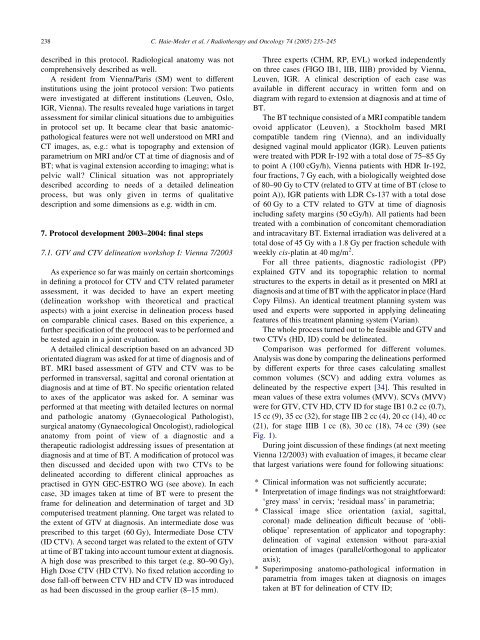Recommendations from Gynaecological (GYN) GEC-ESTRO ...
Recommendations from Gynaecological (GYN) GEC-ESTRO ...
Recommendations from Gynaecological (GYN) GEC-ESTRO ...
Create successful ePaper yourself
Turn your PDF publications into a flip-book with our unique Google optimized e-Paper software.
238<br />
described in this protocol. Radiological anatomy was not<br />
comprehensively described as well.<br />
A resident <strong>from</strong> Vienna/Paris (SM) went to different<br />
institutions using the joint protocol version: Two patients<br />
were investigated at different institutions (Leuven, Oslo,<br />
IGR, Vienna). The results revealed huge variations in target<br />
assessment for similar clinical situations due to ambiguities<br />
in protocol set up. It became clear that basic anatomicpathological<br />
features were not well understood on MRI and<br />
CT images, as, e.g.: what is topography and extension of<br />
parametrium on MRI and/or CT at time of diagnosis and of<br />
BT; what is vaginal extension according to imaging; what is<br />
pelvic wall? Clinical situation was not appropriately<br />
described according to needs of a detailed delineation<br />
process, but was only given in terms of qualitative<br />
description and some dimensions as e.g. width in cm.<br />
7. Protocol development 2003–2004: final steps<br />
7.1. GTV and CTV delineation workshop I: Vienna 7/2003<br />
As experience so far was mainly on certain shortcomings<br />
in defining a protocol for CTV and CTV related parameter<br />
assessment, it was decided to have an expert meeting<br />
(delineation workshop with theoretical and practical<br />
aspects) with a joint exercise in delineation process based<br />
on comparable clinical cases. Based on this experience, a<br />
further specification of the protocol was to be performed and<br />
be tested again in a joint evaluation.<br />
A detailed clinical description based on an advanced 3D<br />
orientated diagram was asked for at time of diagnosis and of<br />
BT. MRI based assessment of GTV and CTV was to be<br />
performed in transversal, sagittal and coronal orientation at<br />
diagnosis and at time of BT. No specific orientation related<br />
to axes of the applicator was asked for. A seminar was<br />
performed at that meeting with detailed lectures on normal<br />
and pathologic anatomy (<strong>Gynaecological</strong> Pathologist),<br />
surgical anatomy (<strong>Gynaecological</strong> Oncologist), radiological<br />
anatomy <strong>from</strong> point of view of a diagnostic and a<br />
therapeutic radiologist addressing issues of presentation at<br />
diagnosis and at time of BT. A modification of protocol was<br />
then discussed and decided upon with two CTVs to be<br />
delineated according to different clinical approaches as<br />
practised in <strong>GYN</strong> <strong>GEC</strong>-<strong>ESTRO</strong> WG (see above). In each<br />
case, 3D images taken at time of BT were to present the<br />
frame for delineation and determination of target and 3D<br />
computerised treatment planning. One target was related to<br />
the extent of GTV at diagnosis. An intermediate dose was<br />
prescribed to this target (60 Gy), Intermediate Dose CTV<br />
(ID CTV). A second target was related to the extent of GTV<br />
at time of BT taking into account tumour extent at diagnosis.<br />
A high dose was prescribed to this target (e.g. 80–90 Gy),<br />
High Dose CTV (HD CTV). No fixed relation according to<br />
dose fall-off between CTV HD and CTV ID was introduced<br />
as had been discussed in the group earlier (8–15 mm).<br />
C. Haie-Meder et al. / Radiotherapy and Oncology 74 (2005) 235–245<br />
Three experts (CHM, RP, EVL) worked independently<br />
on three cases (FIGO IB1, IIB, IIIB) provided by Vienna,<br />
Leuven, IGR. A clinical description of each case was<br />
available in different accuracy in written form and on<br />
diagram with regard to extension at diagnosis and at time of<br />
BT.<br />
The BT technique consisted of a MRI compatible tandem<br />
ovoid applicator (Leuven), a Stockholm based MRI<br />
compatible tandem ring (Vienna), and an individually<br />
designed vaginal mould applicator (IGR). Leuven patients<br />
were treated with PDR Ir-192 with a total dose of 75–85 Gy<br />
to point A (100 cGy/h), Vienna patients with HDR Ir-192,<br />
four fractions, 7 Gy each, with a biologically weighted dose<br />
of 80–90 Gy to CTV (related to GTV at time of BT (close to<br />
point A)), IGR patients with LDR Cs-137 with a total dose<br />
of 60 Gy to a CTV related to GTV at time of diagnosis<br />
including safety margins (50 cGy/h). All patients had been<br />
treated with a combination of concomitant chemoradiation<br />
and intracavitary BT. External irradiation was delivered at a<br />
total dose of 45 Gy with a 1.8 Gy per fraction schedule with<br />
weekly cis-platin at 40 mg/m 2 .<br />
For all three patients, diagnostic radiologist (PP)<br />
explained GTV and its topographic relation to normal<br />
structures to the experts in detail as it presented on MRI at<br />
diagnosis and at time of BT with the applicator in place (Hard<br />
Copy Films). An identical treatment planning system was<br />
used and experts were supported in applying delineating<br />
features of this treatment planning system (Varian).<br />
The whole process turned out to be feasible and GTV and<br />
two CTVs (HD, ID) could be delineated.<br />
Comparison was performed for different volumes.<br />
Analysis was done by comparing the delineations performed<br />
by different experts for three cases calculating smallest<br />
common volumes (SCV) and adding extra volumes as<br />
delineated by the respective expert [34]. This resulted in<br />
mean values of these extra volumes (MVV). SCVs (MVV)<br />
were for GTV, CTV HD, CTV ID for stage IB1 0.2 cc (0.7),<br />
15 cc (9), 35 cc (32), for stage IIB 2 cc (4), 20 cc (14), 40 cc<br />
(21), for stage IIIB 1 cc (8), 30 cc (18), 74 cc (39) (see<br />
Fig. 1).<br />
During joint discussion of these findings (at next meeting<br />
Vienna 12/2003) with evaluation of images, it became clear<br />
that largest variations were found for following situations:<br />
* Clinical information was not sufficiently accurate;<br />
* Interpretation of image findings was not straightforward:<br />
‘grey mass’ in cervix; ‘residual mass’ in parametria;<br />
* Classical image slice orientation (axial, sagittal,<br />
coronal) made delineation difficult because of ‘oblioblique’<br />
representation of applicator and topography:<br />
delineation of vaginal extension without para-axial<br />
orientation of images (parallel/orthogonal to applicator<br />
axis);<br />
* Superimposing anatomo-pathological information in<br />
parametria <strong>from</strong> images taken at diagnosis on images<br />
taken at BT for delineation of CTV ID;




